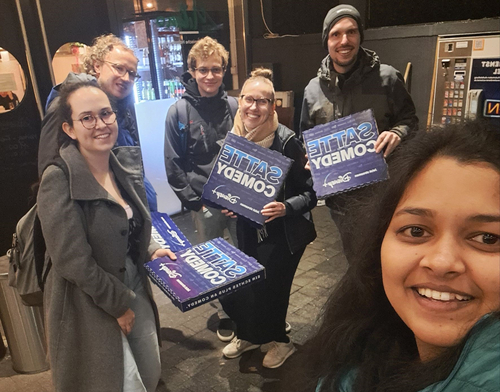Projects Offered
Helle Ulrich Helle Ulrich_actin Helle Ulrich_4R Christof Niehrs_Bioinfo Christof Niehrs_4R Christof Niehrs_Ageing SvenDanck_4R Jan Padeken_4R Andreas Wachter_4R Roopesh Anand_4R Petra Beli_4R Brian Luke_4R Dorothee Dormann_4R Thomas Hofmann_4R Maria Felicia Basilicata_4R Katja Luck Sina Wittmann Sandra Schick Stamatis Papathanasiou Ari Waisman Wolfram Ruf Uwe Wolfrum Johannes Mayer_SkinDC Johannes Mayer_Exhaust Johannes Mayer_APCPhysical and chemical changes within the microenvironment affect antigen presenting cell function
1 PhD project offered in the IPP winter call Molecular Biomedicine & Ageing
Scientific Background
Immune cell function are heavily dependent on external signals. In most immunological studies the focus lies on biological molecules like antigens, cytokines, chemokines, growth factors, etc., while physical and chemical changes are often neglected.
However changes in pH, salt and other ions, as well as physical changes such as tissue stiffness are drastically different between tissues in homeostasis and disease and can impact immune cell functions. Especially infiltrating immune cells such as T cells and myeloid cells are exposed to these changing microenvironments, which might results in context specific functionality. Especially in the context of the tumor microenvironment functional changes related to pH, salt and tissue stiffness have been associated with reduced immune cell functionality in T cells, while other cell populations have not been studied extensively.
Our previous work has shown that dendritic cells, which stochastically reach all tissues, including tumors, have distinct tissue specific phenotypes. Similarly, other myeloid cells such as monocytes and macrophages adapt to their local micromilieu. We therefore hypothesis that these changes are, at least in part, determined by the different physical and chemical microenvironment they encounter and leads to functional changes that result in distinct T cell activation profiles.
PhD project: Physical and chemical changes within the microenvironment affect antigen presenting cell function
Within this project we have three sub-aims:
Aim 1: Develop in vitro models to study the effects of pH, gas levels, salt and other ions, as well as tissue stiffness/pressure in monocytes, macrophages and dendritic cells
Aim 2: Identify the molecular sensing machinery of physical and chemical changes in antigen presenting cells and selectively impair these mechanisms
Aim 3: Study the role of sensing physical and chemical changes in the physiological microenvironment by comparing the cellular functionality of modified antigen presenting cells in different tissues and tumors
This project utilizes immortalized cell lines, freshly generated primary immune cells from murine bone marrow, as well as in vivo models of cancer, to identify a fundamental biological sensing mechanism in immune cells and assess its relevance in disease.
In Aim 1 you will develop strategies to study the effects of pH, gas levels, salt and other ions, as well as tissue stiffness/pressure in monocytes, macrophages and dendritic cells. Many protocols already exist to study these changes in T cells and you will translate them to study immortalized and primary myeloid cells (generated from murine bone marrow progenitors) and their morphological, phenotypical and functional changes. Through these experiments you will become an expert in immunological techniques, such as high-dimensional flow cytometry, RNAseq and T cell cocultures, which represent key expertise of our lab.
In Aim 2 you will apply molecular techniques, such as western blotting, co-IP and KO-generation to identify the molecular sensing machinery of physical and chemical changes in antigen presenting cells and selectively impair these mechanisms. Being highly knowledgeable in these molecular techniques is therefore a pre-requisite for this project.
In Aim 3 you will use these findings to study the role of sensing physical and chemical changes in vivo and compare the cellular functionality of modified antigen presenting cells in skin and tumors.
If you are interested in this project, please select Mayer (APC) as your project preference in the IPP application platform.
Publications relevant to this project
Mayer JU, Hilligan KL, Chandler JS, Eccles DA, Old SI, Domingues RG, Yang J, Webb GR, Munoz-Erazo L, Hyde EJ, Wakelin KA, Tang SC, Chappell SC, von Daake S, Brombacher F, Mackay CR, Sher A, Tussiwand R, Connor LM, Ortega DG, Jankovic D, Gros GL, Hepworth MR, Lamiable O, Ronchese F (2021) Homeostatic IL-13 in healthy skin directs dendritic cell differentiation to promote TH2 and inhibit TH17 cell polarization. Nat. Immunol., 1 (13). Link
Malissen B, Tamoutounour S, Henri S. (2014) The origins and functions of dendritic cells and macrophages in the skin. Nat Rev Immunol. (6):417-28 Link
Alraies Z, Rivera CA, Delgado MG, Sanséau D, Maurin M, Amadio R, Maria Piperno G, Dunsmore G, Yatim A, Lacerda Mariano L, Kniazeva A, Calmettes V, Sáez PJ, Williart A, Popard H, Gratia M, Lamiable O, Moreau A, Fusilier Z, Crestey L, Albaud B, Legoix P, Dejean AS, Le Dorze AL, Nakano H, Cook DN, Lawrence T, Manel N, Benvenuti F, Ginhoux F, Moreau HD, P F Nader G, Piel M, Lennon-Duménil AM. (2024) Cell shape sensing licenses dendritic cells for homeostatic migration to lymph nodes. Nat Immunol. (7):1193-1206. Link
Soll D, Chu CF, Sun S, Lutz V, Arunkumar M, Gachechiladze M, Schäuble S, Alissa-Alkhalaf M, Nguyen T, Khalil MA, Garcia-Ribelles I, Mueller M, Buder K, Michalke B, Panagiotou G, Ziegler-Martin K, Benz P, Schatzlmaier P, Hiller K, Stockinger H, Luu M, Schober K, Moosmann C, Schamel WW, Huber M, Zielinski CE (2024) Sodium chloride in the tumor microenvironment enhances T-cell metabolic fitness and cytotoxicity. Nat Immunol. Link
Contact Details
Prof. Dr Johannes Mayer
Email
Website UMC
Website Mayer Lab
